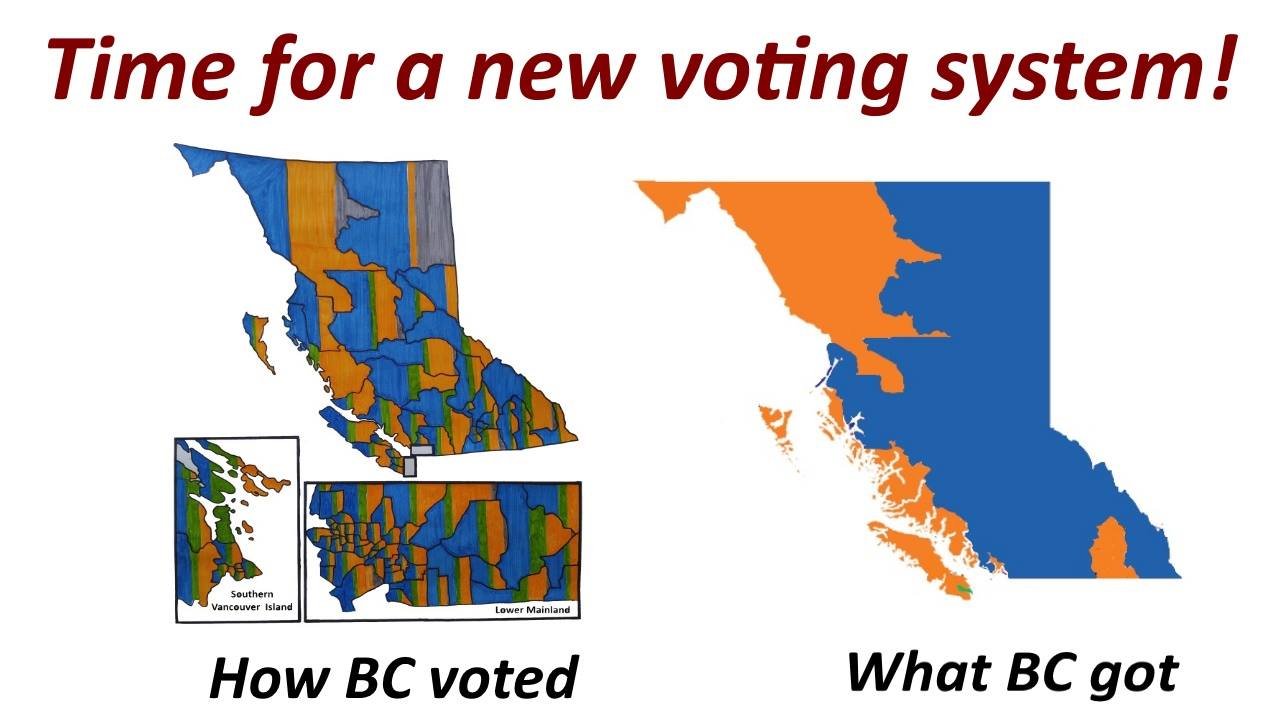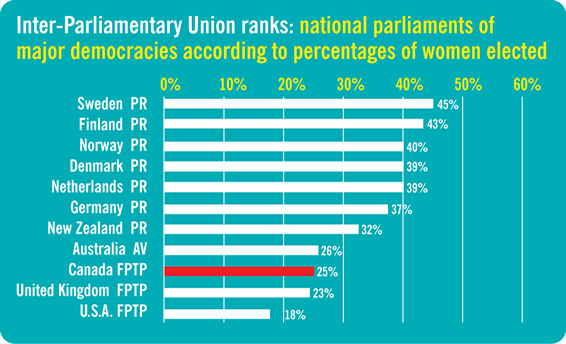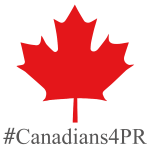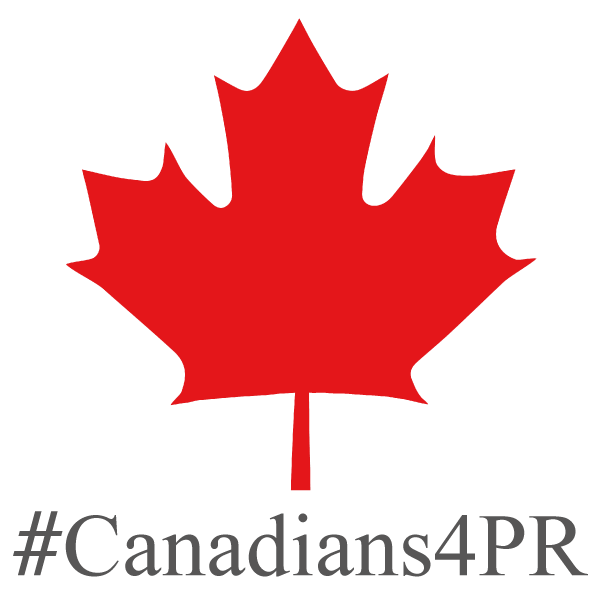It’s a no-brainer that as a democracy, our government should proportionally reflect the diversity of Canadian voters, and that everyone’s vote should have equal power to elect someone to represent us every time we vote. But changing the system can be difficult, and the arguments confusing. Here are some of the reasons why almost 90 democracies across the world have adopted Proportional Representation.
1. Gives every voter equal power to elect someone to represent their values every time they vote.
Proportional representation gives everyone equal power to help elect someone, no matter where they live. Contrast this with First-Past-the-Post where, if you don’t live in the right riding, you can’t elect anyone if you don’t vote for the winner. Around 50% of votes are wasted in this way in every election. As a result, in the 2015 federal election, it took 602,755 votes to elect one Green MP. It only took 37,728 votes to elect a Liberal MP. With a PR system, everyone’s vote would be equal and each MP would be elected by and represent about 52,000 voters.
It is important to note that under PR, the only voters who would not be able to elect someone would be a very small percentage of voters who vote for very small parties. These parties would not be able to elect anyone until they meet a minimum threshold that is usually set at around 4% to 5% of the popular vote. See benefit #8 below.
2. Encourages politicians and parties to work together.
PR will essentially end majority governments in Canada, and this is a good thing for two reasons. First, it will change the competitive atmosphere of politics to a more cooperative one because parties know that they will have to convince another party to work with them in a coalition to form government. Second, coalitions will mean that Canada will always be governed by the wishes of a true majority of voters, which will lead to more overall satisfaction with government.
Read about how New Zealand’s Prime Minister watched as politics changed for the better under PR, or listen to her interview. New Zealand adopted a proportional system known as MMP in 1996, the same type of system recommended for us by the Law Commission of Canada.
3. Gives better local representation.
In our current system, the winning MP in each riding represents the views of only one segment of voters. The rest of the voters in the riding who voted for someone else have no one to represent their views. With PR, voters will have a choice of their local riding MP and several regional MP’s from different parties to choose from.
4. Gives rural and urban voters an equal voice.
Because we only see the winners in each riding, FPTP creates the illusion of a divide between rural and urban voters, or between voters from different provinces. Proportional Representation will allow the diversity of voters from every region to elect someone to represent them, and will more accurately reflect the actual range of support all across Canada. Parties will also have to campaign to that diversity, as they will not be able to target any one region to earn votes.

5. Stronger, more stable government and economy.
Contrary to popular belief, Canada has one of the most unstable governments of all democracies, with 22 elections since WWII, compared to Italy with only 19. This is because FPTP creates a negative atmosphere of competition with parties constantly vying to win a majority government. This causes parties to try to topple minority governments and trigger elections and battle for absolute power rather than choose to work together.
Proportional Representation, on the other hand, creates the expectation of coalition governments, and the expectation of working together, which in turn results in more thoughtful and long-term policy, and more fiscal responsibility. This prevents huge and wasteful policy swings that cause upheaval socially and economically. In fact, it is surprising to find out that, on average, not only are PR governments more stable, corporate taxes are significantly lower in countries with PR. It makes sense that when the government wastes less money, it results in lower taxes overall.
6. Elects more women and minorities.
In the last federal election, 26% of those elected were women, which is lower than the average in countries with proportional systems. Countries that have over 30% women in government all use proportional representation, with the most being Sweden with 43.6%. Why does this happen?
One of the explanations for why PR elects more women and minorities says that when a party can only put forth one candidate per riding, there tends to be a bias towards more successful-appearing white male candidates. However, when voters have a say in more than one candidate, parties tend to put forth a wider range of candidates.

In fact, in countries that use party lists, the parties tend to compete to have the best list of candidates that are the most diverse and representative of the population.
7. Makes more progress in social, environmental and Indigenous issues.
Canadians’ values have changed significantly over the last few decades. With a proportional system, Canadians that support smaller parties will finally be fairly represented and have their concerns addressed. A proportional system will also hold politicians more accountable to their promises, which will work towards more progress in many areas. And, as stated above, the new normal of coalition governments means an end to policy swings, and the beginning of more productive long-term policies that will benefit many social, environmental and Indigenous issues, as they have in many PR countries.
8. Prevents those with extreme views from easily being elected and keeps them from away from positions of power.
The math is simple. With our current system, anyone can win a riding with the most votes in that riding, no matter if that happens to be 20,000 votes or 50,000 votes. In a PR system, minimum thresholds are normally put into place as a safety net. If we set a minimum threshold of 4-5% of the popular vote (all of Canada), it would take approximately 700,000 to 875,000 votes before a party could elect their first candidate. A proportional system clearly makes it much more difficult for parties with unpopular views to elect anyone.
Proportional Representation keeps those with unpopular views from hijacking another party and reaching positions of absolute power, as they have in Ontario and the U.S. PR also keeps the size and influence of unpopular parties predictably small. Most importantly, other parties can simply keep them out by not forming coalitions with them.
9. Holds politicians more accountable to their constituents.
When politicians know that every voter has the power to elect someone, not only will that hold them more accountable, it will make them more responsive to the needs of their constituents. Our current system regularly results in false majorities that give parties 100% of the power with only 40% support and makes no one accountable. FPTP makes it easy for parties to win a majority and then ignore their constituents.
PR will also hold politicians more accountable by eliminating the phenomenon of ‘safe ridings’ and ‘swing ridings’. With votes being equal no matter where you live, parties will no longer be able to win seats by concentrating their campaigns in ridings that will advantage them the most. Parties will have to campaign equally in all ridings in order to drum up voter support. In fact, with PR riding boundaries will actually be of much less importance compared to FPTP, where riding boundaries can have a very significant effect on the overall result.
10. Higher voter turnout.
In Canada, voter turnout was 68.3% in 2015, and hit a low of 58.8% in 2008. We ranked 95th in the world for voter turnout in 2015. In 2011 we ranked 131!
When voters know that their vote will actually have the power to elect anyone they want, they are more motivated to vote. Countries with proportional voting systems have consistently higher voter turnout, and that is good for democracy.
If changing the voting system is important to you, keep in touch. Sign the petition, take the Canadians4PR Pledge, subscribe to the email updates, follow us on Facebook, and take some small actions that make a big difference!


